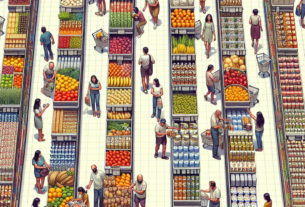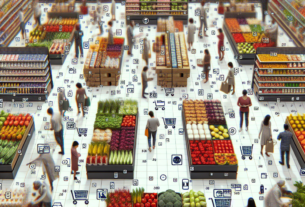The State of the Global Grocery Retail Industry in 2025
The global grocery retail industry has been undergoing significant changes in recent years, driven by the rise of e-commerce and the increasing competition between traditional brick-and-mortar stores and online retailers. Two major players in this industry, Walmart and Amazon, have been at the forefront of these changes, reshaping the way consumers shop for groceries around the world.
Walmart’s Dominance in the Grocery Sector
Walmart, the world’s largest retailer, has long been a dominant force in the grocery sector. With over 11,000 stores worldwide and revenues exceeding $500 billion, Walmart has a significant presence in the global grocery market. In the United States alone, Walmart accounts for more than 25% of all grocery sales, making it the largest grocery retailer in the country.
One of Walmart’s key strengths in the grocery sector is its extensive network of stores, which allows the company to reach a large number of consumers across the country. Walmart’s stores are located in both urban and rural areas, making it convenient for customers to shop for groceries no matter where they live. Additionally, Walmart’s grocery offerings are competitively priced, making it an attractive option for budget-conscious shoppers.
Walmart has also been investing heavily in e-commerce in recent years, in an effort to compete with online retailers like Amazon. The company’s online grocery sales have been growing rapidly, with revenues exceeding $10 billion in 2024. Walmart offers a variety of options for online grocery shopping, including home delivery and curbside pickup, making it easy for customers to order groceries online and have them delivered to their doorstep.
Amazon’s Disruption of the Grocery Industry
Amazon, the e-commerce giant, has been disrupting the grocery industry with its acquisition of Whole Foods Market in 2017. Whole Foods, known for its high-quality organic products, has given Amazon a foothold in the brick-and-mortar grocery market, allowing the company to reach a new segment of consumers who value organic and natural foods.
In addition to its physical stores, Amazon has been rapidly expanding its online grocery business through its Amazon Fresh and Amazon Pantry services. Amazon Fresh offers same-day and next-day delivery of groceries to customers in select cities, while Amazon Pantry allows customers to order non-perishable grocery items online and have them delivered to their door.
Amazon’s Prime membership program has also been a key driver of its success in the grocery sector. Prime members receive free two-day shipping on eligible items, as well as access to exclusive deals and discounts on groceries. This has helped Amazon attract a loyal customer base and drive sales in its grocery business.
Competition and Collaboration Between Walmart and Amazon
While Walmart and Amazon are fierce competitors in the grocery sector, they have also found ways to collaborate in certain areas. For example, Walmart partners with Amazon for its fulfillment services, allowing customers to pick up their Amazon orders at Walmart stores. This partnership benefits both companies by increasing foot traffic to Walmart stores and providing Amazon customers with a convenient pickup location.
Both Walmart and Amazon have also been investing in technology to improve the customer experience in their grocery businesses. Walmart has introduced scan-and-go technology in some stores, allowing customers to scan items with their smartphones and pay without having to wait in line. Amazon has been experimenting with cashier-less stores, where customers can simply grab items off the shelves and walk out without having to go through a checkout line.
Overall, Walmart and Amazon are reshaping the global grocery retail industry with their innovative approaches to online and offline shopping. As these two retail giants continue to compete and collaborate, consumers can expect to see more convenient and efficient ways to shop for groceries in the future.
Visit: CulinaryCoverage.com for more information on the state of the global grocery retail industry in 2025.



